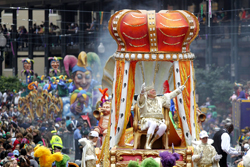Royal Invitation to Mardi Gras Extended to Western New Yorkers
By Frank Parlato
 |
| King Rex is represented here during a Mardi Gras Parade. |
The carnival season leading up to the Mardi Gras on March 4 has begun in New Orleans, as it does each year on Jan. 6, after the Twelfth night, the final and 12th day of Christmas, which is, of course the traditional day of the Epiphany. Apropos of that, this publication received a proclamation from the Rex organization's School of Design asking us to inform our readers that they are welcome to attend, at their own expense, the many parades, masquerade balls, and king cake parties that have been arranged this year, as they are every year, in New Orleans attendant to the carnival season. It heats up, we are told, especially, in the two weeks before and through the Tuesday of Mardi Gras, which is always the day before Ash Wednesday.
The Rex organization began creating its "Royal Invitation" in 1872, and it comes from "King Rex" and invites people to come to the Crescent City to join in its unique celebration. In the days before mass media, broadcast, and tourism industries, these art posters and brochure invitations were distributed in railroad stations, plastered on train cars, posted in centers of commerce, and placed in public buildings around the nation in major U.S. cities. In large part, it popularized the Mardi Gras.
We received ours through email. The 2014 Royal Invitation incorporates artwork from 1886, inviting visitors to "gather, from far and near, to join in the many celebrations and processions which will shortly unfold under the joyful Carnival banner."
The Uptown and Mid-City parade routes are family-friendly gatherings for citizens of all ages to enjoy. On Mardi Gras day itself, men and women appear in "grotesque, quizzical, diabolic, horrible, strange masks," and disguises such as humans with the heads of beasts and birds, and beasts and birds with human heads; demi-beasts, demi-fishes, snakes' heads and bodies with arms of apes; man-bats from the moon; mermaids; satyrs, beggars, monks, and robbers. These parade and march on foot, on horseback, in wagons, carts, coaches, cars, up and down the streets, shouting, singing, laughing, drumming, fiddling and fifing, in an apparently reckless way. This has been going on for more than 160 years.
Aside from parades, balls and other activities, on Bourbon Street and the French Quarter it is not uncommon for more ribald activities to take place and it is a fact that women perform a sort of "ritual disrobement" in which they bare their breasts in exchange for cheap trinkets, something ladies have been doing here since at least 1889.
New Orleans' first and oldest Krewe, the Mystick Krewe of Comus started in 1856.
Mardi Gras is also known as Shrove Tuesday or Fat Tuesday. The day is one of deliberate excess since the next day begins the religious fasting or abstaining that commences with Lent.
Lent, which is the Teutonic word for Spring, is a period for fasting, prayer, meditation and penitence to prepare for, if one is Catholic, the coming of Holy Week and Easter. The carnival celebrations are in effect, the ancient celebration for the people which begin after the 12th day of Christmas and continue to the end of the winter.
In any event, we were cordially asked by the Rex Organization to pass on the glad tidings of their Mardi Gras event to our readers so that they may come to New Orleans and witness the Creole, French and Americans mingle with celebrants from around the world as they perform their rituals, and, in the spirit of friendship with the celebrants, we obligingly have done so.